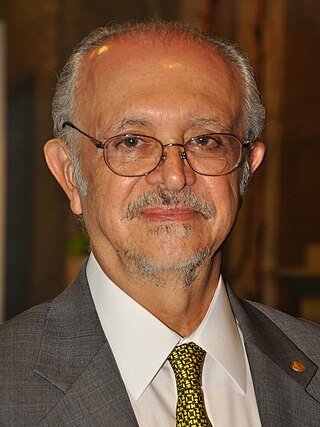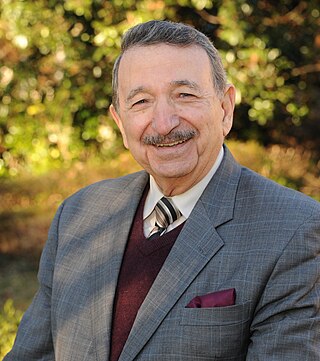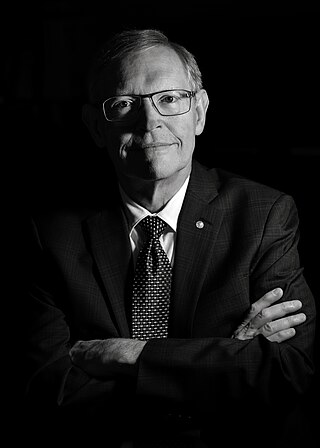
Gerhard Heinrich Friedrich Otto Julius Herzberg, was a German-Canadian pioneering physicist and physical chemist, who won the Nobel Prize for Chemistry in 1971, "for his contributions to the knowledge of electronic structure and geometry of molecules, particularly free radicals". Herzberg's main work concerned atomic and molecular spectroscopy. He is well known for using these techniques that determine the structures of diatomic and polyatomic molecules, including free radicals which are difficult to investigate in any other way, and for the chemical analysis of astronomical objects. Herzberg served as Chancellor of Carleton University in Ottawa, Canada from 1973 to 1980.
Donald James Cram was an American chemist who shared the 1987 Nobel Prize in Chemistry with Jean-Marie Lehn and Charles J. Pedersen "for their development and use of molecules with structure-specific interactions of high selectivity." They were the founders of the field of host–guest chemistry.

Mario José Molina-Pasquel Henríquez was a Mexican physical chemist. He played a pivotal role in the discovery of the Antarctic ozone hole, and was a co-recipient of the 1995 Nobel Prize in Chemistry for his role in discovering the threat to the Earth's ozone layer from chlorofluorocarbon (CFC) gases. He was the first Mexican-born scientist to receive a Nobel Prize in Chemistry and the third Mexican-born person to receive a Nobel prize.

Mostafa A. El-Sayed is an Egyptian-American physical chemist, nanoscience researcher, member of the National Academy of Sciences and US National Medal of Science laureate. He is known for the spectroscopy rule named after him, the El-Sayed rule.
Chi-Tang Ho is a Chinese-born American food scientist. He received his PhD in organic chemistry in 1974 and started working as a researcher and professor in the food science department at Rutgers University. He is now director of the food science graduate program at Rutgers University in New Brunswick, New Jersey.

George McClelland Whitesides is an American chemist and professor of chemistry at Harvard University. He is best known for his work in the areas of nuclear magnetic resonance spectroscopy, organometallic chemistry, molecular self-assembly, soft lithography, microfabrication, microfluidics, and nanotechnology. A prolific author and patent holder who has received many awards, he received the highest Hirsch index rating of all living chemists in 2011.

William Esco Moerner, also known as W. E. Moerner, is an American physical chemist and chemical physicist with current work in the biophysics and imaging of single molecules. He is credited with achieving the first optical detection and spectroscopy of a single molecule in condensed phases, along with his postdoc, Lothar Kador. Optical study of single molecules has subsequently become a widely used single-molecule experiment in chemistry, physics and biology. In 2014, he was awarded the Nobel Prize in Chemistry.
Sylvia Teresse Ceyer is a professor of chemistry at MIT, holding the John C. Sheehan Chair in Chemistry. Until 2006, she held the chemistry chair of the National Academy of Sciences.

Chad Alexander Mirkin is an American chemist. He is the George B. Rathmann professor of chemistry, professor of medicine, professor of materials science and engineering, professor of biomedical engineering, and professor of chemical and biological engineering, and director of the International Institute for Nanotechnology and Center for Nanofabrication and Molecular Self-Assembly at Northwestern University.

Daniel George Nocera is an American chemist, currently the Patterson Rockwood Professor of Energy in the Department of Chemistry and Chemical Biology at Harvard University. He is a member of the National Academy of Sciences and the American Academy of Arts and Sciences. In 2006 he was described as a "major force in the field of inorganic photochemistry and photophysics". Time magazine included him in its 2009 list of the 100 most influential people.
Joseph S. Francisco is an American scientist and the former president of the American Chemical Society from 2009 to 2010. He currently serves as the President's Distinguished Professor of Earth and Environmental Science and professor of chemistry at the University of Pennsylvania. He was the Dean of the College of Arts and Sciences, and held the Elmer H. and Ruby M. Cordes Chair in chemistry at the University of Nebraska in Lincoln until 2018.
William Albert Noyes Jr., commonly known as W. Albert Noyes Jr., was an American chemist known for his contributions to photochemistry. During World War II, he was a leader in U.S. defense research efforts. He chaired the chemistry department at the University of Rochester, edited several important chemistry journals, and throughout his career was a prominent voice for international scientific cooperation. He was the son of the renowned chemist William A. Noyes; they became the first father-son pair to win the Priestley Medal, the highest honor given by the American Chemical Society.
Goverdhan Mehta is an Indian researcher and scientist. From 1998-2005 he was the director of the Indian Institute of Science (IISc). Previously from 1977-1998, Mehta was a professor of chemistry and vice-chancellor at the University of Hyderabad. Mehta has authored over 550 research papers.

Bernard Lucas "Ben" Feringa is a Dutch synthetic organic chemist, specializing in molecular nanotechnology and homogeneous catalysis.
Jai Pal Mittal is an Indian scientist, DAE Raja Ramanna Fellow of Bhabha Atomic Research Centre and Distinguished Professor of Indian Institute of Technology, Mumbai, the National Academy of Sciences, India and the University of Pune. He is known for his researches in the fields of photochemistry and radiation chemistry. He was honoured by the Government of India in 2003 with Padma Shri, the fourth highest Indian civilian award.
Kakkudiyil George Thomas is an Indian photochemist, nanomaterial scientist and a professor at the Indian Institute of Science Education and Research, Thiruvananthapuram. He is known for his studies on photoresponsive nanomaterials and is an elected fellow of the Indian National Science Academy and the Indian Academy of Sciences. The Council of Scientific and Industrial Research, the apex agency of the Government of India for scientific research, awarded him the Shanti Swarup Bhatnagar Prize for Science and Technology, one of the highest Indian science awards, in 2006, for his contributions to chemical sciences.
Clifford P. Kubiak is an American inorganic chemist, currently a Distinguished Professor in Chemistry and Biochemistry and the Harold C. Urey Chair in Chemistry at the University of California, San Diego. Over the course of his career, Kubiak has published over 200 scientific articles. He has also received the American Chemical Society Award in Inorganic Chemistry, and is a Fellow of the American Academy of Arts and Sciences and American Chemical Society. In 2020 he was elected to the National Academy of Sciences.
Michael Roman Wasielewski is an American physical chemist. He is currently the Clare Hamilton Hall Professor of Chemistry, Director of the Center for Molecular Quantum Transduction (CMQT), and Director of the Institute for Quantum Information Research and Engineering (INQUIRE) at Northwestern University.

Thomas John LeBlanc is a computer scientist and academic administrator. He was the 17th President of the George Washington University from July 2017 to December 2021.
The Ullyot Public Affairs Lecture is an annual public lecture which focuses on contributions of the sciences to the public welfare. The lecture is presented jointly by the Science History Institute, the American Chemical Society (ACS), the University of Pennsylvania, and the University of the Sciences. The lecture was endowed in 1990 by Glenn Edgar Ullyot, a research chemist at Smith, Kline & French, and his wife Barbara Hodsdon Ullyot. Since 1997, the lecture has been presented at the Science History Institute in Philadelphia, Pennsylvania.














